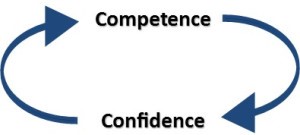“The most pathetic person in the world is someone who has sight but no vision.”
― Helen Keller
In our previous post on self reflection, we discussed the importance of self reflection—i.e., taking the time to review what you do throughout your daily life and why you do it. From this practice, you have now most likely identified some gaps in where you are right now and where you want to be – sometimes called “The Gap Analysis” But before you get too excited and charge headfirst into bridging those gaps and eliminating the things that are not working, it’s helpful if you first create a vision or a roadmap for yourself. Most people wouldn’t start a journey without having a map or a confirmed end destination, and this concept applies to this process.
In this post, we will delve in depth about the different aspects of creating a vision for yourself, setting goals, and following them through to achievement.

SETTING A VISION
“If you don’t build your own dream, someone else will hire you to help build theirs.”
― Tony Gaskins
Before you make your roadmap, you first have to clearly envision your end destination the place where you end up.
The term “vision” might sound daunting, but it shouldn’t be. “Vision” is simply defined as “the ability to think about or plan the future with imagination or wisdom,” and we can all do this quite easily. Your vision is where you want to be and your path for how you’ll get there. Depending on what you want to achieve in life, this may be a simple or f you identify the gap as being significant it will be quite detailed. There is no right or wrong vision because it’s personal—something that only you can decide for yourself— and this process is to help you recognise that importance of creating your own unique vision.
To begin laying out your roadmap start by thinking of the basic ideas of where you want to be/get to. Make this 1st step an overarching, big picture idea; it should be something that you can flash up in your mind instantly. For example, maybe your vision is to be debt free by the time you’re 40, to be working only 30 hours a week, to have 8 weeks vacation each year. Whatever your vision is, it does need to be something a bit more tangible than “rich” or “famous” or even just “healthy,” because vague visions don’t work. In order to be truly attainable, it needs to be solid and specific—something that creates a clear-cut image in your mind. Try reading Jeff Goins – The Art of Work http://artofworkbook.com/
Crafting your own vision may take a little time, and that’s completely okay! There’s no need to rush the process, because this should be something that’s important and meaningful to you and the chances are if you have not really thought it out before its a skill that you need time to hone. If you are a more visual person, you can use a Vision Board to better articulate what you want (“a picture is worth a thousand words,” after all). Or you can create one online bh connecting and sharing yours with other people using Dreamboard. By sharing you create some transparency and a layer of accountability which is always a good thing.
“The visionary lies to himself, the liar only to others.”
― Friedrich Nietzsche
Why is it so important to set a vision?

“Create a vision of the life you want is one of the most effective strategies for achieving the life of your dreams. The best way to look at it, is using your vision as a compass to guide you to make the best decisions, and take the best actions that will help propel you toward your bigger and fuller life. A Life Vision Statement will create a clearer path for your life.”
-Patricia Young: From “7 Easy Tips for Creating Your Life Vision Statement”
Quite simply: the way you think determines your reality. Your beliefs and way of thinking will eventually begin to manifest themselves in the world around you and in what you attract into your life.
When you create a vision it also motivates you to push against your self-imposed boundaries. In our last post, we asked you to think of 2 or 3 instances in your life when you set a specific goal of something you wanted to achieve, to think about how hard you worked towards it and how good it felt to achieve that goal. Using these powerful emotions and sense of achievement, combined with the knowledge that you can do anything you set your mind to, you apply this technique to your new vision. The self-reflection that you’ve completed will help you identify what matters most to you in life, and suddenly your vision moves from ethereal to tangible.
How to create your own vision:
- Do you know your purpose? Don’t overthink it and don’t get too esoteric; your purpose doesn’t have to be “finding the cure to cancer” or “ending world hunger.” Your purpose is just the motivating factor that gets you up each day; it’s the thing that makes life feel meaningful and important to you. Your purpose is based on your values and beliefs about yourself and the world around you. If you are stuck, here are 9 questions to help you.
- What have your personality tests revealed about you? As you get to know yourself better, you will be able to create a purpose and vision that is aligned with your own talents and personality traits. Don’t set your vision based on anyone else’s values except your own.
- What did your Venn diagram look like? Remember from our last post when you found the “sweet spot”—the overlap between the things you’re really good at and the things you really enjoy doing? Create a vision for yourself that enables you to spend as much time as possible in that sweet spot of your Venn diagram.
As you think about these questions and ideas, take some time to brainstorm the things that are most important to you and the things that bring you pleasure in life. Allow yourself to think freely and creatively, so that you don’t rule out anything that you might not have previously considered.
When you’re brainstorming what to do/be/have/give, consider what you would do if you had no limitations: For example, what if money and health were not obstacles for you?
Also, think about the people you admire and what it is that they have, do, and are that you want to emulate. You might even want to ask one of these people to be your mentor, to help you think through these areas (at least partly), and to tell you what he/she has found to be effective for them.
You’ll want to give yourself a peaceful environment so you can truly brainstorm. And, you do want to brainstorm, which means: you write it all down, and you throw out nothing, no matter how ridiculous it sounds. When you try to mix brainstorming and practicality, you always lose the benefit of brainstorming. You’ll have time later to be practical with your list.
-Taken from “Succeeding in Life Through Setting Goals” by Bruce Keener
My personal example:

Let me share my own personal example of how I created a vision for myself and planned a roadmap to reach my goals.
I really wanted to work in a casino onboard cruise ships and I set my vision around this and about how achieving that goal would feel and look like. I was told that it was really hard to get this kind of job, as being a croupier was a specialised skill and even harder still to get a job on a cruise line. Instead of listening to the negative feedback I took an 8-week course to learn how to deal, practicing my chip handling skills at night and on weekends (I put the extra effort in). I only applied to work on cruise lines (including turning down other good jobs whilst I waited). I even took a menial, low-paying job while I waited to be accepted to a position on a cruise ship, knowing that if I took a really good job it would distract and deflect me from reaching my ultimate aim.
Did it work out? Hell yes! For 9 years, I worked on cruise ships, travelling the world and visiting some of the most amazing places on this earth. I did have one downside when the ship sunk but I lived to tell the tale and have some great anecdotes to tell at parties. When you have a vision and are yet to reach it, the road can sometimes seem long and your goal far away, however for me it was worth that initial short-term sacrifice I made to make my dream come true.
The 4 Levels of Competence
“Create a vision for the life you really want and then work relentlessly towards making it a reality.”
― Roy T. Bennett, The Light in the Heart
Everyone will tell you—success doesn’t happen overnight and they are correct however very soon after setting your vision, you will move through the these different stages as you progress towards actualizing your dream. It may not seem like success initially but it is progress.
In psychology, this is called the “conscious competence” learning model—this model breaks down the process of learning a new skill into four different stages: unconscious incompetence, conscious incompetence, conscious competence, and unconscious incompetence.
When portrayed as a visual pyramid, it looks something like this:

(Picture from Wikipedia)
Let’s break down each of these stages and take a more detailed look at what they mean and what they look like in daily life.
Unconscious incompetence:
This means that you are behaving incompetently, and you’re not even aware of how your actions are incompetent. You don’t even notice that what you’re doing isn’t the best or most efficient way to do something—you are unconscious of your own incompetence. The length of time spent in this stage will look different for everyone, but before you can get out of this stage, you have to have a strong desire to learn and move forward.
Let’s use music as an example: Perhaps a singer or musician performs a piece of music incorrectly, but they think they’re doing it well. We’ve probably all heard a singer at karaoke or open mic night who might think she is absolutely nailing it, but in reality, she’s completely off-key, and she doesn’t even know it.

Conscious incompetence:
In this stage, you’re still performing incompetently, but now you have become aware that what you’re doing isn’t working well. Ideally, you shouldn’t have to stay very long in this state; from here you can quickly start identifying what’s wrong, learning from your mistakes, and make the necessary changes in order to progress to the next level.
To continue with our musician example; at this stage, the singer knows that she’s off-key and she knows that she’s hitting the incorrect pitches, but she may be unable or unwilling to change her voice to sing the song correctly.
Moving out of the “conscious incompetence” stage (whether in your personal or professional life) means that you need to be open to constructive criticism and to thoughtful suggestions from others who recognise that you are not performing a skill to the best ability. This probably won’t be easy to do! When we allow certain habits to become ingrained in our lives, we often continue with that practice simply because it is comfortable and familiar, regardless of whether or not it is the best way to do something. If a flute player has practiced a piece of music and has learned how to play the wrong note in a certain part of the music, it may be difficult to retrain your fingers to do something different in order to hit the correct note.
Conscious competence:
You are now behaving competently and you are able to execute the desired skill, but it’s probably still a bit difficult for you. You have to think a lot about what you’re doing and about the right way to do it; you have to concentrate intensely on performing the skill competently. Anyone who has ever learned a new skill has been familiar with this stage of learning: when you’re knitting and you have to focus closely on each step of creating a stitch, when you’re learning a new language and you speak very slowly because you have to think so hard about using the correct words, when a teenager learns to drive a car (or even when an adult gets behind the wheel of an unfamiliar car!) and is consciously aware of each step in the process of driving a car.
If you continue diligently in the conscious competence stage, constantly practicing your skill correctly, then you should pretty quickly hit the final stage:
Unconscious competence:
Once you reach this stage, the new skill or habit is now automatic, and you can do it without thinking about it. The skill is easy for you—you might be able to do it simultaneously while performing another task; you might even be able to teach it to others. You can knit a scarf mindlessly while watching TV, you can drive from home to work and back without having to think about what you’re doing.
In “The Four States of Competence Explained,” Examined Existence discusses these four states, and they also recommend adding a 5th stage: Conscious Competence of Unconscious Incompetence—i.e., using your own state of “mastery” to help others progress away from their incompetence.
Knowing vs. Doing
Knowing and doing: they’re two completely different things.
Just because you know something doesn’t mean you’re doing it on a daily basis. For example: Everyone knows that cigarettes are unhealthy – but why do so many people still smoke? Because the mind and the actions aren’t aligned with each other, that’s why!
Sometimes, we just get stuck in a rut just because it’s familiar to us. We might know that our current patterns aren’t making us happy and successful in the long term, but we don’t want to deal with the discomfort of forming new habits and making changes in order to achieve greater happiness and success. In our last post, we talked about cutting out negative thought patterns and bad habits, but it’s not so easy as reading a single blog post and then immediately changing your life. You have to always be on guard; don’t let yourself slip back into negative habits just because it’s the easy thing.
Doing new things and building new habits will be difficult at first. It will be different and foreign and uncomfortable—just like we mentioned above in the four levels of competence, learning any new skill will require a lot of concentration at first. It takes time. Linda Adams uses the four levels of competence to talk about both progressing through pilates classes as well as learning how to use communication skills between leaders and employees within a company in her article “Learning a New Skill is Easier Said than Done.” But even when it’s difficult, you have to keep pushing through until you get to that fourth level, where the new skill is easy and natural for you.
Creating a vision for yourself constitutes as knowing what you want out of life. The next step after that is doing what you have to do in order to get what you want. You have to get out of your head and start being active in what you do to achieve success. Daydreaming is a good start, but it isn’t enough; you have to take conscious steps each day to live out your vision.
So how do you do that? By setting strategic, smart goals. Did you know that even astronauts set goals!
“Everything in this world is created twice: First – creation in your mind, followed by the manifestation in reality. Without the mental creation, there will be no physical creation. When you set a goal, you already accomplish the first creation. You have set into motion a decree for yourself and the forces of your universe to materialize the goal in the physical reality.” – Celestine Chua
Taken from “6 Important Reasons Why You Should Set Goals”

Using the GROW method for creating a vision
SETTING YOUR GOALS – Using The “GROW” Method
One popular method for setting goals is the GROW method. Many business coaches use this method because it is simple, easy to follow, and has a great acronym (okay, just kidding about the last one!). “GROW” stands for:
- Goal
- Current Reality
- Options (or Obstacles).
- Will (or Way Forward).
Let’s break down each of these letters now, and look a little more in-depth about how you can use the easy techniques of this acronym to help you set and measure goals in your life.
GOAL – What are you trying to achieve? The key here is that you want your goals to be specific. “I want to travel more” is not a specific goal. “I want to travel to all 7 continents before I turn 50” is better – do you see why? The second one is measurable – you’ll have concrete evidence when you’ve achieved it – and it has a time frame.
Without being clear and specific, you will likely never really reach your “goals” because they’ll always remain in some sort of vague “eventually I’ll work on that” stage. You can’t really work towards something if you haven’t given yourself a clear goal to work towards! And whatever your goals are, make sure you WRITE THEM DOWN, then keep them somewhere that you can see and reference frequently.
The commonly-used “SMART” acronym is known as “the world’s number 1 goal setting technique” and explains how to make the best goals—you can read more details about how to set SMART goals here, but basically the acronyms means that your goals should be:
Specific
Measurable
Attainable
Realistic
Time-based
You can also take this a step further by “Setting S.M.A.R.T.E.R. Goals” — in this extended acronym, the “E” and the “R” stand for “Evaluate” and “Readjust.” That is, after you have set your “SMART” goals and taken the necessary steps to start achieving those goals, you should then Evaluate your progress and Readjust if anything needs to be changed either in the goal itself or in your approach to it.
For more information on setting goals, you might want to check out this detailed post on “Personal Goal Setting” from MindTools.
REALITY – What does your current gap look like? How far away are you from reaching your goal and achieving your vision? If the gap is quite large what help or steps do you need to put in place to get there? If this is not something you are familiar with do more research, talk to a few people. Alternatively, can you enlist some help so that you get expert advice on what steps are required and in what order? We would only recommend this once you are 100% certain of your goals, because you will begin to spend money when asking experts for advice.
It’s important that you are honest with yourself about your current state of reality. Lying to yourself and being falsely optimistic at this stage will do you no favors. As an example: if your goal is to be debt-free in 20 years and you’re currently sinking under $50,000 worth of debt, it won’t help you if you lie to yourself and say that your debt is less than it really is. What will be helpful is if you are able to point out problematic areas in your spending habits in order to change what’s not working and start planning your way out of debt.
Remember everything we discussed in our last post about self-reflection? The assessment and evaluation skills that you learn when practicing self-reflection are the same skills that will give you the ability to honestly assess your current state of reality.
Whatever you do, don’t be discouraged about the gap between your goal and your current reality—this gap is known as “creative tension,” and it’s an incredibly useful tool in your life.
You create creative tension when you clearly articulate your vision and your current reality, and the gap between your vision and your current reality becomes apparent. This gap creates an emotional and energetic tension that seeks to be resolved.
-Cath Duncan, from “A User’s Guide to Creative Tension”
“The gap between vision and current reality is also a source of energy. If there were no gap, there would be no need for any action to move towards the vision. We call this gap creative tension.” – Peter Senge
OPTIONS/OBSTACLES: What are the obstacles that stand in the way of achieving your goal, and what are your options to overcome those obstacles? This is the time to get creative. If you don’t have the money or time to do exactly what you want just yet, then try some lateral thinking. What short-cuts (or “hacks,” as they are commonly called) can you think of that will speed up the process?
Eventually you’ll want to move past basic problem solving and into the actual creative process, as Patricia Seybold talks about in her post about innovation on Customer Think:
Innovation doesn’t arise out of problem-solving, but out of creativity. It takes you to a different place. In industry, innovation often involves different business models, different materials, different processes, different disciplines. Typically, the “problem” doesn’t get solved; it vanishes. It doesn’t show up. It’s no longer relevant.
As your obstacles diminish, you’ll be free to move on to the next letter of the acronym: W.
WILL/WAY FORWARD – What’s the easiest thing you can do to begin and to build momentum? How will you make new habits to overcome your obstacles, and how will you track those habits? It should start with small decisions and small changes. You might not be able to quit your job overnight, but you can start re-prioritizing your life in little ways. Get a clear idea in your head of what success will look like, and be both optimistic and realistic about a time frame to achieve that success.
Making your way forward to reach your goal is about making small decisions on a regular basis. Changing slowly will increase our chances of success; trying to make too many big changes in your life too quickly is likely to result in burn-out, and may make you feel like giving up. Instead, as you master one or two new habits at a time, you will then be inspired and confident to move on to making another change, and then another, and so on until you’ve reached your goals.
For example; if you want to run a marathon, you don’t go from running 1 mile a day to suddenly running 20 miles a day. Instead, each week you add a little more distance to your runs, and you work on strengthening and cross-training exercises in between. When 1 mile is comfortable to run, push yourself until 2 miles are comfortable, and continue until you’ve slowly worked your way up to the 26 miles of a marathon. This process and path to success is similar for nearly any other goal you set in life.

working towards your vision
BHAG: Big, Hairy, Audacious Goals
“A goal is not always meant to be reached, it often serves simply as something to aim at.” ― Bruce Lee'”
“BHAG” (pronounced “bee-hag”) is a relatively well-known acronym in the business world. It stands for “Big, Hairy, Audacious Goal,” and it refers to a goal that sounds “too big”—for example, if the owner of a small, local bookstore sets a goal to own the biggest bookstore in the world. If you’re curious, you can read more about BHAG’s in Entrepreneur Magazine’s article “In The BHAG.”
But BHAG’s are not just for big businesses. A big, hairy, audacious goal, whether in your personal or professional life, serves to give you something to work towards, something to give you excitement and vision in your life or your company.
Your own BHAG’s might be objectively bigger or smaller depending on your own vision and purpose; what is important is that it is something big for you, something that pushes you to excel and to keep moving forward with your life and vision. Whether it’s a personal goal or a goal for a team or company that you are a leader of, it has to be a goal that’s personalized to fit your unique vision, and you have to know why you’re setting that goal.
Still want to know more about goals?
When it comes to setting goals that work for you and to learning about why goal-setting is an important skill to master in your life, there’s a lot of information to be found out there—the resources are almost endless!
For even more advice on goal-setting, check out James Clear’s comprehensive and informative take on things in his article “A Scientific Guide to Setting and Achieving Goals.” You might also want to give a listen to Lewis Howes and Michael Hyatt’s podcast “The Secret to Successful Goal-Setting.”
But don’t get too caught up in reading and listening—you’ve got to get out there and do the work to complete your goals too! You can start with writing down your goals. These worksheets, which are geared towards educators to give to students might be helpful in giving you an idea on how to set your goals in clear, attainable statements. Some of them are quite juvenile, but a few of them are also applicable for adult use—especially this one.
Confidence-Competence Loop
As you set goals and you do the work to achieve those goals, you will find yourself getting better and better at the competencies required to bring your vision to fruition. The better you get at a particular skill, the more confident you become with it, and the more confident you are, the more competent you will be, creating a continuous loop that keeps building on itself. For example, a first-year teacher may feel shy and insecure, and the lack of confidence often shows both to students and to mentors who observe and critique the beginning teacher. But as the teacher spends more time in the class and gains competence, their confidence will also grow—and that sense of confidence will help them be a better teacher. The confidence-competence loop is relevant in any area of life.

confidence competence loop
Picture taken from “Productivity Requires Fertility” – Read more here.
Moving on…
Okay, so now you’ve got the big picture idea of what you want out of life. You’ve already learned about self reflection as a tool for getting to know yourself and assessing what’s working or not working in your life. Now you’ve spent some time thinking about creating a vision for yourself, and about setting clear, attainable goals in order to achieve that vision. From here, it’s time to start with the small steps of implementation of that vision. This means forming and nurturing habits that will help you to advance in life. We’ll be talking about forming good habits in our next blog post.
“When I dare to be powerful, to use my strength in the service of my vision, then it becomes less and less important whether I am afraid.”
― Audre Lorde
“If I paint a wild horse, you might not see the horse… but surely you will see the wildness!”
― Pablo Picasso

